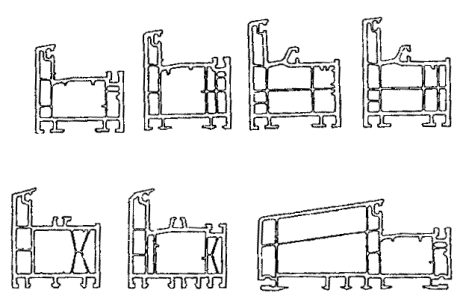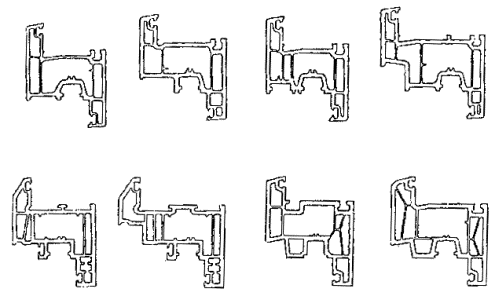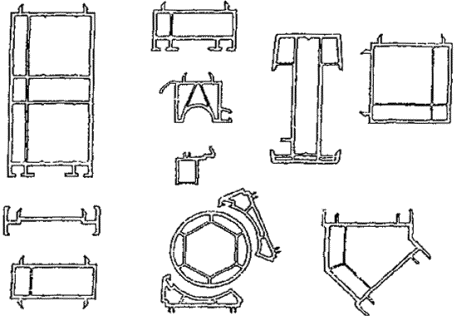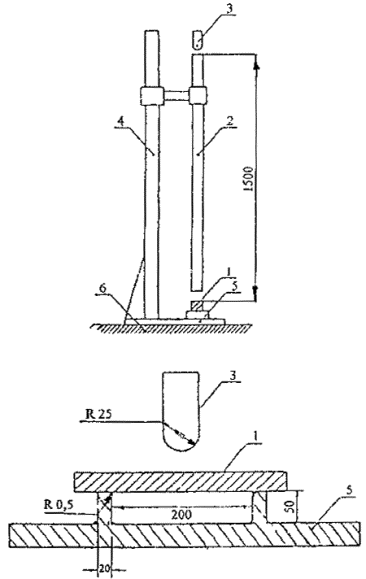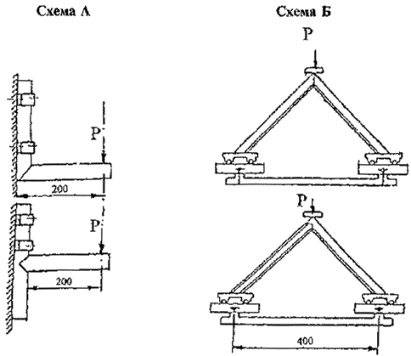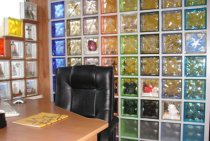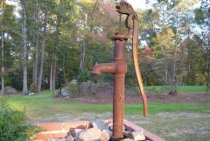3 Property characteristics
5.3.1 Indicators of physical and mechanical properties of profiles
must meet the requirements specified in .
Table 3
Meaning
Strength at
tension, MPa, not less than*
37,0
Module
tensile strength, MPa, not less than*
2100
impact strength
according to Charpy, kJ/m2, not less*
15
Temperature
Vicat softening, °C, not less*
75
The change
linear dimensions after thermal exposure, %, not more than:
for major
profiles
2,0
difference in change
linear dimensions on the front sides
0,4
for additional
profiles
3,0
Heat resistance
at 150 °C for 30 min
There should be no swelling, cracks, delaminations
Resistance to
impact at negative temperatures
Destruction of no more than one sample out of ten
Color change
white profiles after irradiation in the Xenotest device, gray scale threshold, not
more
4
The change
impact strength after irradiation in the apparatus "Xenotest",%, no more
20
Notes
1 Rated
the values of indicators marked with * are indicated in the technical
manufacturer's documentation.
2 Limit
deviation of the Vicat softening point from the value set in
technical documentation should not exceed (± 3) °С.
3 Heat resistance
profiles with decorative laminated and co-extruded coating
tested at 120 °C.
4
The impact resistance of window sill boards is tested at a positive temperature.
On the
On non-facial surfaces of products, minor extrusion defects are allowed:
stripes, risks, etc.
Indicators
appearance of profiles: color, gloss, quality of front and non-front surfaces
(surface defects) - must match the color, gloss and quality
surfaces of reference samples agreed in the prescribed manner.
After
removal of the protective film, the appearance of the products must comply with the requirements
of this standard.
5.3.6 Color (colorimetric) characteristics of profiles
must be in the range: L³90;
-3.0ab5,0.
At
this deviation from the nominal values of the color characteristics of profiles,
established in the technical documentation of the manufacturer (or standard samples),
must not exceed: L 1,0; a£0,5; b£1,0; Eab£1,3.
Limit
deviations of the nominal color characteristics of additional profiles, invisible at
operation of products, it is allowed to install by agreement of the manufacturer with
consumer.
Note - The requirements of this paragraph are mandatory
from 1.07.2001
Durability
profiles must be at least 40 conditional years of operation. Until 07/01/2002
the value of the durability index is 20 conditional years of operation.
on
scheme A, not less than:
1200 N - for sashes (including for strapping cloths
balcony door blocks), 2500 N - for strapping door leaf panels, 1000 N
- for boxes;
on
scheme B, not less than:
2400 N - for sashes (including for strapping cloths
balcony door blocks), 5000 N - for strapping door leaf panels, 2000 N
- for boxes.
Estimated
strength values of corner joints for profiles of specific sections
set in the technical documentation of the manufacturer.
Note — Requirements for the strength of welded joints of profiles
classes B and C are established in the regulatory and technical documentation for
specific types of products of these classes.
5.3.10 Values of the reduced resistance index
heat transfer of a combination of profiles intended for operation in
heated rooms are (0.40-0.90) m2 × ° C / W, depending
on the number, location and size of cameras.
5.3.13 Profiles must have a hygienic conclusion
bodies of the State Sanitary and Epidemiological Supervision, drawn up in the prescribed manner. When it changes
formulations of the extruded mixture should be re-evaluated
products.
Profiles
during operation and storage should not have a harmful effect on the body
person.
9 Manufacturer's warranties
9.1 The manufacturer guarantees compliance
profiles to the requirements of this standard, subject to compliance by the consumer
rules for their transportation and storage, as well as manufacturing, installation and
exploitation of their products.
9.2 Warranty period of storage of products at the consumer - 1 year
from the date of shipment of products from the manufacturer's warehouse.
9.3 Guaranteed service life of profiles in finished window and
door blocks (absence of hidden profile defects) - at least five years from
day of product release.
Examples of profile sections
Sections of box profiles
Sections
mullion profiles
Sections of faceplate profiles
Sash profile sections
Cross sections of connecting and
extension profiles
Sections of glazing beads
Section of window sill profile
Sections of decorative profiles
The composition of the working documentation for PVC profile systems
working
documentation for PVC profile systems for window and door units should
include the following data:
B.1
Requirements and characteristics of PVC profiles:
—
drawings of sections of profiles with indications of their functions and division into main and
additional profiles, profile articles;
—
basic and functional dimensions of profiles with tolerances;
—
sectional drawings of profile nodes with dimensional tolerances;
—
physical and mechanical characteristics and durability of PVC profiles;
—
information about the decorative and finishing coating of profiles, including a catalog of reference samples;
—
design strength of welded joints.
B.2
Requirements and characteristics of amplifying inserts:
—
insert material, type and thickness of anti-corrosion coating;
—
sections with basic dimensions and calculated moments of inertia.
B.3
Seal requirements:
material,
dimensions, section shapes, characteristics.
B.4
Requirements for windows and doors:
—
methods and schemes for opening window and door blocks;
—
tables (diagrams) of the maximum allowable dimensions (proportions) of sashes;
- types
reinforcing inserts depending on the size of doors, boxes, imposts,
crossbars;
—
requirements for fastening reinforcing inserts
—
designs of mechanical T-joints: description of connecting
parts, reinforcements, fasteners, gaskets and sealants;
—
drawings of the location of holes for water drainage, drainage of glazing seams,
wind pressure compensation, indicating their dimensions;
—
information about the locking devices and hinges used, their number and
location;
—
schemes for mounting double-glazed windows and installing linings for glazing;
—
instructions for the manufacture of windows, including the main technological modes;
—
installation instructions and operating instructions.
APPENDIX
V
Information about the developers of the standard
Real
The standard was developed by a working group of specialists consisting of:
N.V.
Shvedov (head of development), Gosstroy of Russia;
V.A.
Tarasov, ZAO KVE Window Technologies;
X. Scheitler, KBE GmbH;
E.S.
Guzova, JSC "Polymerstroymaterialy";
IN AND.
Tretyakov, JSC "Polymerstroymaterialy";
V.G.
Milkov, NUTSC "Interregional Window Institute".
|
Keywords: profiles |
15 Determination of heat resistance
1 — sample; 2
- a pipe with an inner diameter of (50 + 1) mm; 3 — striker; 4 — tripod; 5
— support; 6 — foundation
Figure 3 — Scheme of a device for determining resistance
profiles to hit
Camera
temperature (drying cabinet), providing temperature maintenance up to 200
°C.
Thermometer
for measuring air temperature up to 200 °C with a division value of 1 °C.
Ruler
metal according to GOST 427;
Stopwatch.
Plate
glass.
Talc.
Sample
placed horizontally on a glass plate, previously sprinkled
talc, and placed in a chamber in which it is kept for (30 ± 1) min. Then
the sample is removed, cooled in air to room temperature and examined.
Sample
considered to have passed the test if there is no
damage, and on the end surface - bundles and shells.
Result
tests are considered satisfactory if all three samples have withstood
tests.
7.16 Tensile strength of welded joints
(welding strength factor) is determined according to GOST 11262 with the following
additions.
Facilities
tests and auxiliary devices - according to .
From
front walls, welded according to the technological regulations for at least a day
before testing the profiles, six samples are cut along, of which three samples are whole and three samples are welded
a seam in the middle, perpendicular to the longitudinal axis of the sample (weld overlays
are removed).
Result
tests are obtained by comparing the arithmetic mean values of strength
whole and welded samples.
7.17 Determination of strength (bearing capacity) of corner
welded joints are produced according to schemes A or B.
the value
loads are taken according to the calculated values of the strength of corner joints
for profiles of specific sections specified in the design documentation
manufacturer.
Figure 4 — Definition
strength of fillet welds (for fillet joints at 90° and
T-joint)
Samples
profiles are welded on the equipment and according to the modes established in
technological regulations. For testing, three samples of angular
sash connections, door leaf straps or frames. ends of two segments
profiles cut at an angle of (45 ± 1) ° are welded at an angle of (90 ± 1) °, overlays,
formed at the welding site are not removed.
Free
the ends of the samples are cut at an angle of (90 ± 1) ° or at an angle of (45 ± 1) ° to their longitudinal
axes depending on the test scheme.
The dimensions of the samples and the schemes for applying the load are given on.
When tested according to scheme A, the sample of one of the sides is rigidly
fixed to a vertical or horizontal support. To the other side in
load is applied to the plane of the sample (for example, using a screw
fixtures). The load is measured with a dynamometer. Samples are loaded up to
destruction.
Car
for profile welding.
Ruler
metal according to GOST 427.
Goniometer
with vernier according to GOST 5378.
The specimen is placed on the fixture in such a way that
so that the free ends of the sample are located on the carriages, and the longitudinal axis
of the loading punch and the top of the gusset sample coincided between
yourself.
V
case of testing profiles with an asymmetric side profile to achieve
uniform loading of the cross section of the sample, counter-profile
inserts and gaskets.
Sample
loaded to failure.
Testing machine providing load measurement with
error not more than 3% of the measured value. Punch speed -
(50±5) mm/min.
Car
for profile welding.
Punch
pressure.
fixture,
consisting of a support beam and two movable support carriages with articulated
fastening to the traverse ().
inserts
and pads.
Ruler
metal according to GOST 427.
Goniometer
with vernier according to GOST 5378.
results
tests are considered positive if the values of the breaking load at
test of each sample exceed the values of the control load,
set in the design documentation.
7.17.6 Until 01.01.2002 it is allowed to control
strength of welded joints by non-destructive method according to scheme A: with vertical
sample location, a control free load is applied (load - according to , permissible load deviations - ± 5%, speed
loading is not regulated) on the horizontal side of the sample (for example,
manually on a cable or wire). In this case, the specified load value is obtained
by sequential application of loads weighing no more than 25.0 kg. Samples
withstand under load for at least 3 minutes. The test result is recognized
positive if each sample has withstood the load without failure and
crack formation.
